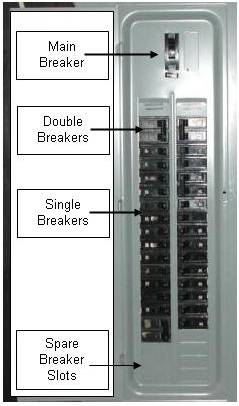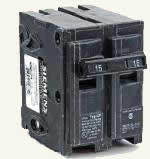- If the circuit breaker has not tripped when each appliance or electrical device is activated you are most likely facing an overload situation. An overload occurs when the total current required to run a combination of lights and/or appliances and/or electrical devices is greater than the rating of the circuit breaker.
- The circuit breaker is weak and hence is defective and is turning itself off even when an overload on the circuit is not present.
This can be proven by turning on all of the light switches and each appliance to the ON
position, one at a time, at some point when turning on an additional item the circuit breaker should trip. This proves that it is the total current being called for that is causing the circuit breaker to trip.
If you are experiencing breakers tripping because of overloads, the only method of correcting the problem is to split up the load amongst other circuits. This may be as simple as plugging one of the appliances or electrical devices into another receptacle, or reducing the wattage of light bulbs in light fixtures or not running the coffee pot, toaster and griddle all at the same time.
However, we are a society that increases the use of electrical consumption daily! If you do not have enough electrical circuits to service your needs you may have to consider adding additional electrical circuits.
Note: Circuit breakers are designed to protect you from overheated wires. The answer to an overloaded circuit is NOT to replace the current circuit breaker with a circuit breaker that can carry a greater load. As an example replacing a 15 amp circuit breaker with a 20 amp circuit breaker.
A circuit breaker is a mechanical device that does wear. The springs and bimetal strips housed within the plastic housing become weak and will no longer hold the rated current of the breaker.

Figure 3 - Electrical distribution panel (load center)
One of the biggest mistakes made is to use the circuit breakers as if they are switches. Circuit breakers are not designed (with a few exceptions) to be turned ON
and OFF
continually, in other words, to act as a switch. Using circuit breakers as switches is a very common occurrence in industrial warehouses and production plants.
If you have a breaker that seems to trip to the OFF
position for no reason, it is possible that you have a worn or defective circuit breaker.
Remember that some electrical appliances and devices in your home are turning themselves ON
and OFF
without your assistance. Electrical heaters are usually controlled by thermostats that work independent of personal intervention. Computers and other equipment may have internal fans that come on when a thermostat located within the device calls for cooling. Outdoor lights and garage door openers are other items which may be controlled remotely or on timers.
Investigate the electrical circuit that is tripping the breaker in detail before deciding that it is defective breaker.
Make sure that it is not a device turning itself on that is causing an overload on the circuit.

Figure 3 - Two pole circuit breaker
To replace a defective circuit breaker the power to the distribution panel (load center) should be turned off. A load center (distribution panel) will have either a manual disconnect switch connected between the electrical meter and the panel or an integral main circuit breaker (Figure 3) located either at the top or bottom of the panel.
Note: It is possible with a double breaker, (Figure 3) used for 240 VAC nominal circuits, common for water heaters, air conditioning and stoves, that only one side of the breaker is actually tripping. You must replace the complete 2 pole breaker.
Although physically possible, you should not replace a single 2 pole breaker with 2 - single pole breakers unless the handles are tied together. This is for safety, the tie between the circuit breaker handles prevents an operator from turning OFF
only half of the circuit.
Purchase a circuit breaker that matches the breakers in the panel. Each manufacturer has a different method of mechanically connecting the breaker to the electrical panel. Some use screws, others use a push/pull configuration.
Additional information on troubleshooting flickering lights.
